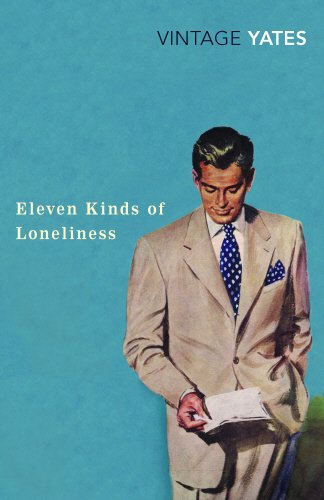
photo © starmanseries
by JL Bogenschneider
If my work has a theme, I suspect it is a simple one: that most human beings are inescapably alone, and therein lies their tragedy ~ Richard Yates
Better known for his novels – most notably, Revolutionary Road – Richard Yates published less than twenty short fictions. His 1962 collection, Eleven Kinds of Loneliness, covers similar ground to that of his long-form work: young men and women, often coupled, emerging from the rubble of the post-war era into the bright future of The American DreamTM, only to find it less than it should be.
‘Fun with a Stranger’ departs from this trope. The second of two pieces in the collection set in a school, it describes two terms in the life of a number of third-graders (Year 4 in the English parlance; we’re talking eight and nine-year-olds here) and their teacher, the woe-betiding and stationery obsessed Miss Snell:
Probably sixty, a big rawboned woman with a man’s face […] She was strict and humourless, preoccupied with rooting out the things she held intolerable: mumbling, slumping […] and, the worst of all, “coming to school without proper supplies”.
We all know teachers like this, whether fictional or in the flesh. Order is the order of the day and Miss Snell runs a tight ship, not as some looming, monstrous figure, but through a stultifying regime of rigidity and monotonousness.
She never seemed to lose her temper, but it would almost have been better if she did, for it was the flat, dry, passionless redundance of her scolding that got everybody down. When Miss Snell singled someone out for a special upbraiding, it was an ordeal by talk.
She is particular about her pupils not coming to school properly equipped and the illicit request to borrow a pencil is met with a lecture. Miss Snell extols the virtues of taking care of one’s personal items, citing her own clumpy eraser which she has had – hold your breath – for five years. Even the most well-behaved pupil  can’t escape punishment when they slip up – Miss Snell is fair and just – with the boys, as well as the girls, prone to tears in the face of such impassive, humourless penalty. ‘And ironically, it always seemed to be during the lull after one of these scenes […] that the noise of group laughter would float in from Mrs. Cleary’s class across the hall.’
can’t escape punishment when they slip up – Miss Snell is fair and just – with the boys, as well as the girls, prone to tears in the face of such impassive, humourless penalty. ‘And ironically, it always seemed to be during the lull after one of these scenes […] that the noise of group laughter would float in from Mrs. Cleary’s class across the hall.’
Mrs. Cleary is the counterweight in the story. Her classes are educational and entertaining; the teacher you always hoped you’d get. Young, attractive and – perhaps significantly – married, she takes the other half of the third grade.
The natural response of Miss Snell’s charges to Mrs. Cleary’s might be passive-aggressive envy – and so it is, when Miss Snell’s pupils John Gerhardt and Howard White try to avoid the smug Taylor twins with their effusive tales of learning in Mrs Cleary’s class. But, even so, the less fortunate pupils can’t help but remain loyal to their teacher in the face of questioning from the others as to how bad she really is. “Well, not too bad…” is their answer.
Despite her faults, Miss Snell tries. In fact, she tries so hard and so desperately that it’s painful for even the reader to witness. She was nice, the narrator tells us, ‘in an awkward, groping way of her own’. Take her fulcrumic speech, delivered partway through the first term:
“When we learn a new word it’s like making a new friend. And we all like to make friends, don’t we? Now, for instance, when school began this year you were all strangers to me, but I wanted very much to learn your names and remember your faces, and so I made the effort. It was confusing at first, but before long I’d made friends with all of you. And later on we’ll have some good times together – oh, perhaps a little party at Christmastime, or something like that – and then I know I’d be very sorry if I hadn’t made that effort, because you can’t very well have fun with a stranger, can you?” She gave them a homely, shy smile. “And that’s just the way it is with words.”
Even the third grade can recognise good intentions when they see them, and so they put up with the otherwise insufferable Miss Snell. If only she would acquit herself in some way, show some demonstrable advantage over the too-perfect Mrs. Cleary, it might be alright. But a joint-class field trip simply shows her to be the sapping dullard of repute, and in the presence of Mrs. Cleary’s class too. Still, her pupils don’t quite give up on her, and with the end of the second term approaching, they remain hopelessly positive that their sadsack of a teacher will come good. The earlier, oblique, overly blasé reference to a Christmas party is not forgotten, and surely no-one – not even the strictest, most unforgiving educator – can be that joyless at a time like Christmas.
But Yates is a realist and not even the third grade are to be spared disappointment. That’s not to say Miss Snell doesn’t make an effort, but that she does so with such spectacular mundanity – she gives her charges each a Christmas-wrapped eraser, ‘the serviceable ten-cent kind’ – the awkwardness is palpable from the page. Not only that, but her pupils feel sorry for her in the worst possible way: she is pitied.
Miss Snell stood at the head of the class, her clasped fingers writhing like dry worms at her waist, her face melted into the soft, tremulous smile of a giver. She looked completely helpless.
Compare this with the humourless, man-faced spinster we’re first introduced to. Over the course of two terms and eleven pages, Yates has transformed the bogey figure of the dread teacher into a shy, vulnerable, tangible being. He has a particular knack of empathising with  even the most flawed of his characters; fanning out their vulnerabilities like a poker hand to prove that they’re human, like the rest of us.
even the most flawed of his characters; fanning out their vulnerabilities like a poker hand to prove that they’re human, like the rest of us.
It isn’t made explicit as to whether Miss Snell is lonely or not, but she is isolated, from her pupils and her colleague. Her stiff admonition to Mrs Cleary, via a pupil who interrupts one of her classes with a message, suggests that she might be, at least partly, responsible for this isolation. But she does her best, she reaches out – the way we all do – although ultimately she fails.
That her reputation precedes her implies she has never connected with any of the children she has taught, and likely never will, but that doesn’t stop her from trying (that speech of hers, you can bet she gives it every year). We feel for her, even care about her and admire her tenacity, but – like her pupils – we can only come away with pity. Poor Miss Snell, the antithesis of fun, forever to be a stranger.
Kurt Vonnegut once wrote of Yates’ work, ‘Few men since Flaubert have offered such sympathy to women whose lives are hell’. But in ‘Fun with a Stranger’, Yates barely offers Miss Snell anything, only puts her forward for the reader to observe; such delicate characters need handling carefully, if at all. He simply sketches a few scenes, holds them up to the reader as if to say, ‘Just look at this, will you?’ and has us come to our own conclusions, whilst simultaneously offering no real choice in what to conclude. There is little ambivalence in his stories, but there are shades that allow us to at least understand the characters we’re presented with, and this is all Yates asks of his readers. He doesn’t ask that the people he writes about be liked – think of Frank and April Wheeler in Revolutionary Road – only that they be understood.
~
JL Bogenschneider writes short fiction and has had work featured most recently in Ambit, Bare Fiction, Hobart Literary Journal and Litro.


